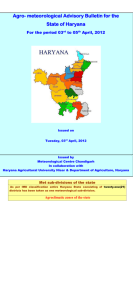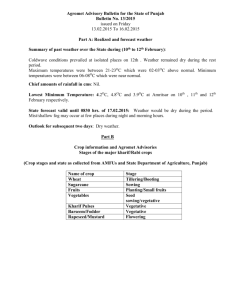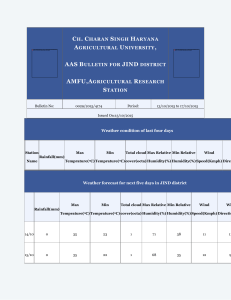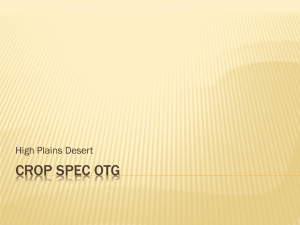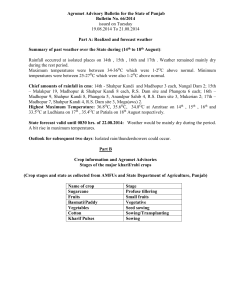Issued on - Agricultural Meteorology Division
advertisement
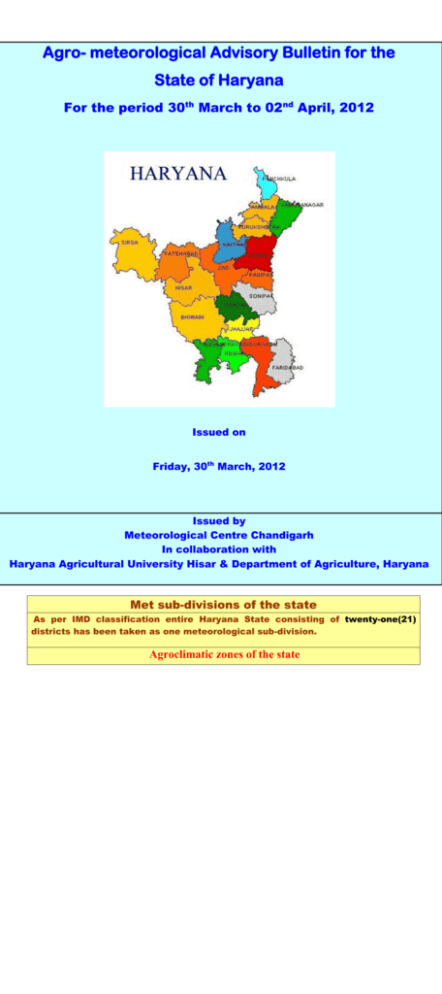
Agro- meteorological Advisory Bulletin for the State of Haryana For the period 30th March to 02nd April, 2012 Issued on Friday, 30th March, 2012 Issued by Meteorological Centre Chandigarh In collaboration with Haryana Agricultural University Hisar & Department of Agriculture, Haryana Met sub-divisions of the state As per IMD classification entire Haryana State consisting of twenty-one(21) districts has been taken as one meteorological sub-division. Agroclimatic zones of the state No. Agroclimatic Zone Districts Agromet Field Unit (AMFU) Location 1 Eastern zone Panchkula, Ambala, Faridabad, Kurukshetra, Karnal, Kaithal, Yamunanagar, Panipat, Sonepat & Parts of Jind, Rohtak, Jhajjar, Gurgaon and Mewat. Kaul (Kaithal) 2 Western zone Sirsa, Fatehbad, Hisar, Bhiwani, Narnaul, Mahendergarh, Rewari, Parts of Jind, Rohtak , Jhajjar, Gurgaon and Mewat. Hisar Part I: Weather Significant Past Weather in different agroclimatic zones Weather Forecast for different agro-climatic zones For the period 27/03/2012 to 29/03/2012. valid until 0830 hrs of 03/04/2012 (Area Covered in 50 Km radius around the station) Eastern zone Weather remained mainly dry during the period. Sunny days are likely in the region. Rise in day and Chief amounts of rainfall in cms: Nil. night temperatures. Mean maximum temperature was around 310 C which was near normal. Mean minimum Outlook for subsequent two days : Partly cloudy temperature was around 18 deg. C which was 1- days. 2 deg. C above normal. The average morning and afternoon relative humidity were 60 and 35 percent respectively. The average wind speed during the period was 06 km/hr. Western zone Weather remained mainly dry during the period. Sunny days are likely in the region. Rise in day and Chief amounts of rainfall in cms: Nil. night temperatures. 0 Mean maximum temperature was around 32 C which was near normal. Mean minimum Outlook for subsequent two days : Partly cloudy temperature was around 15 deg. C which was days. slightly below normal. The average morning and afternoon relative humidity were 68 and 35 percent respectively. The average wind speed during the period was 05 km/hr. Part II: Agroclimatic Zonewise Agricultural/Agro-meteorological Advisories Eastern zone Wheat Fodder Sugarcane Animal husbandry Vegetables & Fruits Oil Seeds Summer Pulses For crop sown after 5 December, need based irrigation can be given. Care should be taken not to irrigate the crop on windy/stormy day. Sow early summer and multicut fodder during this month to meet fodder scarcity during summer lean period. Coserve surplus Barseem as hay and oats as silage for cheap milk production during lean period. Irrigate the crop at 7-12 days interval for better growth of the crop. Apply 65 kg urea to ratoon crop and give irrigation. Make sure that all the animals are vaccinated against FMD, if still not, then get them vaccinated immediately, keep their record and repeat after six months. Regularly deworm the calves with piperazine liquid (4ml/kg body weight) first at 15 days of age then 22 days and one month upto 3 months of age and 3 monthly upto 1 year of age. Do not feed green, sprouted, soiled or rotton potatoes to dairy animals. Theses can cause serious and fatal poisoning. This is the best time to raise the broiler chicks. Purchase the chicks from a reliable source. Clean and disinfect the sheds properly before the arrival of chicks. Maintain 95 ºF temperatures under the brooder during first week and reduce it by 5 ºF every week. Deworm the chicks regularly and timely. Don’t store the compound feed for more than 15 days. Don’t use infected grains for feed formation. Sow nursery of onion variety Agri Found Dark Red to produce bulb sets for planting kharif season crop. Sow 5 kg seed to produce enough bulb sets for planting an acre. Sow either variety Punjab Padmini or Punjab 7 or 8 of Okra for better yields in this season. Apply light irrigation after 10-12 days. Spray tomato crop with 100 ml of Sumicidin 20 EC per acre in 100 litres of water per acre to check the attack of fruit borer. • The young as well as the old trees should be irrigated regularly and more frequently as they put forth new growth, flushes. The lower portion of the exposed trunks should be whitewashed with a thick lime solution. Young plants (fully established) may be given nitrogenous fertilizer in small split doses. To check fruit fly in ber, spray 500 ml of Rogor 30 EC in 300 litres of water. Stop spraying atleast 15 days before fruit picking. The crop is ready to harvest when the pods turn yellow. Timely sown raya and taramira should be harvested during this week and owing to grain shattering in raya care should be taken to harvest it at the proper time. Sowing of summer moong (SML-668) and summer mash (Sathi mash, i.e. Mash 1008 or Mash-414 or Mash-218) may be started from middle of March onward. Use 15 kg seed rate per acre for summer moong and 20 kg for summer mash. Western zone Wheat Fodder Vegetables & Fruits Sugarcane Animal Husbandry For crop sown after 5 December, need based irrigation can be given. Care should be taken not to irrigate the crop on windy/stormy day. Sow early summer and multicut fodder during this month to meet fodder scarcity during summer lean period. Coserve surplus Barseem as hay and oats as silage for cheap milk production during lean period. Sow nursery of onion variety Agri Found Dark Red to produce bulb sets for planting kharif season crop. Sow 5 kg seed to produce enough bulb sets for planting an acre. Sow either variety Punjab Padmini or Punjab 7 or 8 of Okra for better yields in this season. Apply light irrigation after 10-12 days. Spray tomato crop with 100 ml of Sumicidin 20 EC per acre in 100 litres of water per acre to check the attack of fruit borer. • The young as well as the old trees should be irrigated regularly and more frequently as they put forth new growth, flushes. The lower portion of the exposed trunks should be whitewashed with a thick lime solution. Young plants (fully established) may be given nitrogenous fertilizer in small split doses. To check fruit fly in ber, spray 500 ml of Rogor 30 EC in 300 litres of water. Stop spraying atleast 15 days before fruit picking. Irrigate the crop at 7-12 days interval for better growth of the crop. Apply 65 kg urea to ratoon crop and give irrigation. Make sure that all the animals are vaccinated against FMD, if still not, then get them vaccinated immediately, keep their record and repeat after six months. Regularly deworm the calves with piperazine liquid (4ml/kg body weight) first at 15 days of age then 22 days and one month upto 3 months of age and 3 monthly upto 1 year of age. Do not feed green, sprouted, soiled or rotton potatoes to dairy animals. Theses can cause serious and fatal poisoning. This is the best time to raise the broiler chicks. Purchase the chicks from a reliable source. Clean and disinfect the sheds properly before the arrival of chicks. Maintain 95 ºF temperatures under the brooder during first week and reduce it by 5 ºF every week. Deworm the chicks regularly and timely. Don’t store the compound feed for more than 15 days. Don’t use infected grains for feed formation. Oil Seeds Summer Pulses The crop is ready to harvest when the pods turn yellow. Timely sown raya and taramira should be harvested during this week and owing to grain shattering in raya care should be taken to harvest it at the proper time. Sowing of summer moong (SML-668) and summer mash (Sathi mash, i.e. Mash 1008 or Mash-414 or Mash-218) may be started from middle of March onward. Use 15 kg seed rate per acre for summer moong and 20 kg for summer mash.
